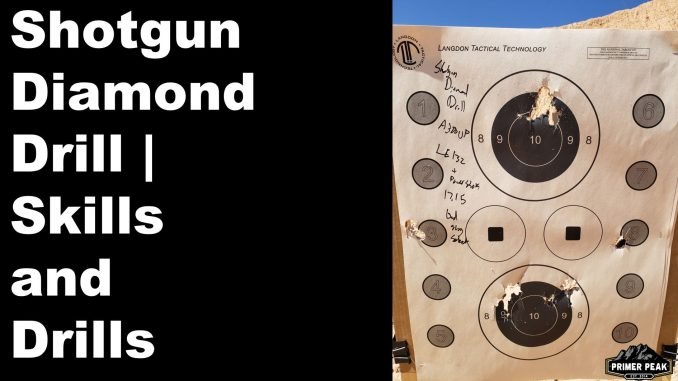
A few months ago I was asked to come up with a shotgun drill that utilizes the B-8 Repair Center target. For weeks I wracked my brain trying to come up with something fun and functional, while also reasonable on a relatively small target. Finally I’ve come up with the Shotgun Diamond Drill. This drill incorporates substantial shot accountability, port and magazine loading, target transitions, and more. Let’s take a closer look at the Shotgun Diamond Drill.
Setting Up the Drill
Setting up the Shotgun Diamond Drill is fairly straightforward. You’ll need a single LTT-1 target, laying vertically on your backer. Place this target at seven yards, everything will be shot from here. In total this drill requires four rounds of buckshot, and two slugs. Begin with one round of buckshot in the chamber, and another round in magazine, with your spare ammunition stored based upon shooter’s preference. For example, I keep my slugs brass-up and buckshot brass-down in a side saddle, whereas others have mixed side saddles and butt cuffs to separate ammunition types.
Safety position is shooter’s choice, finger off the trigger. Finally you’ll need a shot timer record your times.
Scoring the Shotgun Diamond Drill
Scoring the Shotgun Diamond Drill is fairly simple. Any pellets landing outside of the B8 is a failure, and add 0.25 seconds to your par time per pellet. Slugs landing outside of the designated 2″ circles result in failure, and add 0.50 seconds per instance. Line breaks count towards passing on both the 2″ circles, and the B8. Rounds fired out of sequence add 0.50 seconds per instance.
There are no provisions for different action types, different sighting systems, or different loads. So someone shooting a Remington 870 with a bead sight and #4 buck is scored the same as a Beretta 1301 with an Aimpoint and Federal Flite Control LE133. As we can see, results can be heavily skewed by poor performing loads, just like in real life. Choose wisely.
Par times are as follows:
- 10 seconds or less: Expert
- 10-13 seconds: Advanced
- 13-16 seconds: Intermediate
- 16 seconds or more: Novice
Firing the Drill
The start position is low ready, with your muzzle at the base of the target, facing down range. On the beep, fire 2x buckshot into the top B8. Next, port load a single slug, then fire into the “3” circle on the left of the target. Port load a single round of buckshot, then load a second round of buck into the tube, and fire both into the lower B8. Finally, port load a single slug and fire it into the “8” circle on the right side of the target. All rounds are fired as a single string without stopping.
For you visual learners out there, I’ve created a short video demonstrating the drill. You can find it >>HERE<<
Reasoning Behind the Drill
Why did I write the Shotgun Diamond Drill in such a way? Simply put, I wanted to get as much out of one drill as I could, while keeping the logistics as simple as possible for shooters. There’s no movement, and only one target is required, allowing this to be shot at most indoor ranges. For facilities that restrict silhouette targets, the LTT-1 is about as benign as you can find. The B8 bullseye is known to be anatomically significant, being similarly sized to “A-Zone” chest circles on most qualification targets. The 3″ dots along the side of our LTT-1 act as simulated distance or exposure targets, requiring a refined sight picture and additional deliberation to get good hits. Finding the proper 2″ dot can also be a challenge, as hits on just any circle does not equal a pass, requiring you to actually see your target before firing.
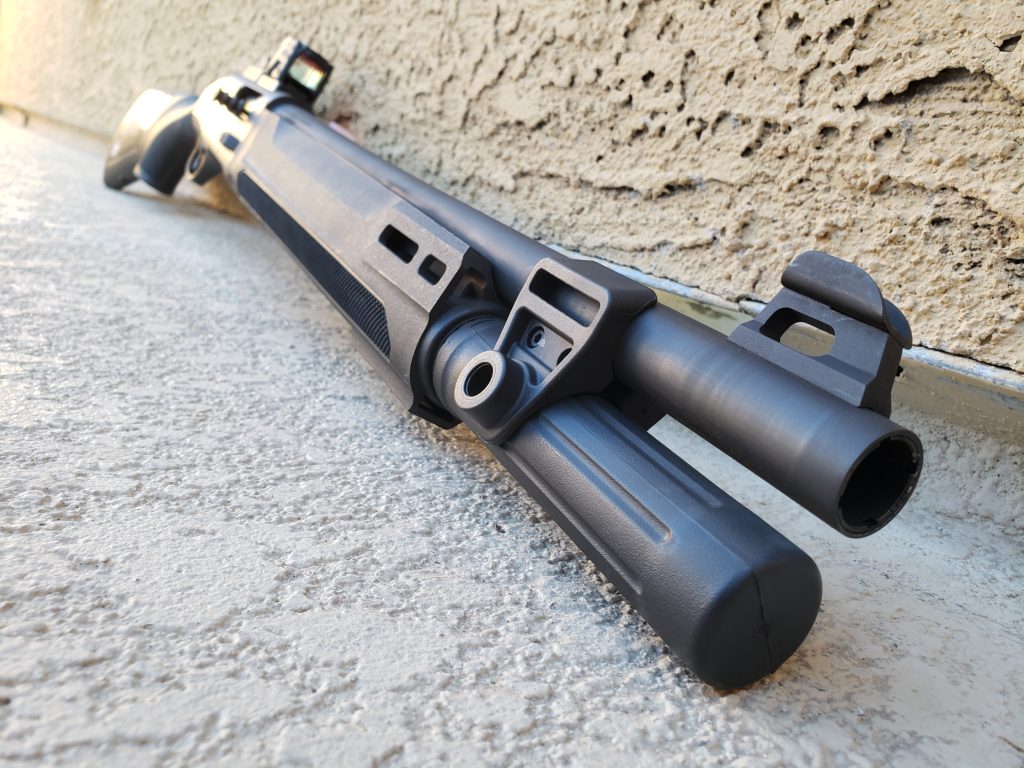
The typical shotgun engagement is solved with a single round, but that isn’t always the case. Requiring two rounds on the B8 helps to check follow-through and consistency, while the accuracy requirement forces shooters to think about their chosen defensive load. Cheap ammo will not have good results, and the fallout could be much more serious on the streets than on the range. Reloads of both the tube and port are tested, along with consciously selecting the appropriate ammunition for the task at hand. With our stringent time standards, shooters must learn which reloading technique is more effective, both for speed and reliability. Finally we must know how our sights align with our ammunition, checking for differences in pattern and grouping of both slugs and buckshot.
My Results on the Shotgun Diamond Drill
I’ve fired the Shotgun Diamond Drill many times while developing it over the course of several weeks. During development, I tested this with a cylinder bore Mossberg Maverick 88, Remington 870P with an IC and CYL choke, and a Beretta A300UP with an IC choke. Sights include bead, rifle sights, and a Steiner MPS. Ammunition has been 8 and 9 pellet Federal Flite Control, and Hornady Critical Defense. All of these have resulted in passing attempts. I say this to show the work done to vet different gun and ammunition combination’s ability to clear the drill.
Beretta A300 Ultima Patrol, Improved Cylinder, Steiner MPS
- 14.12, clean, Hornady Critical Defense
- 14.16, clean, Hornady Critical Defense
- 17.15, clean, Hornady Critical Defense
- 12.73, Failure–slug on incorrect circle, Hornady Critical Defense
Remington 870P, Improved Cylinder, Rifle Sights
- 15.78, clean, Hornady Critical Defense
- 15.95, clean, Hornady Critical Defense
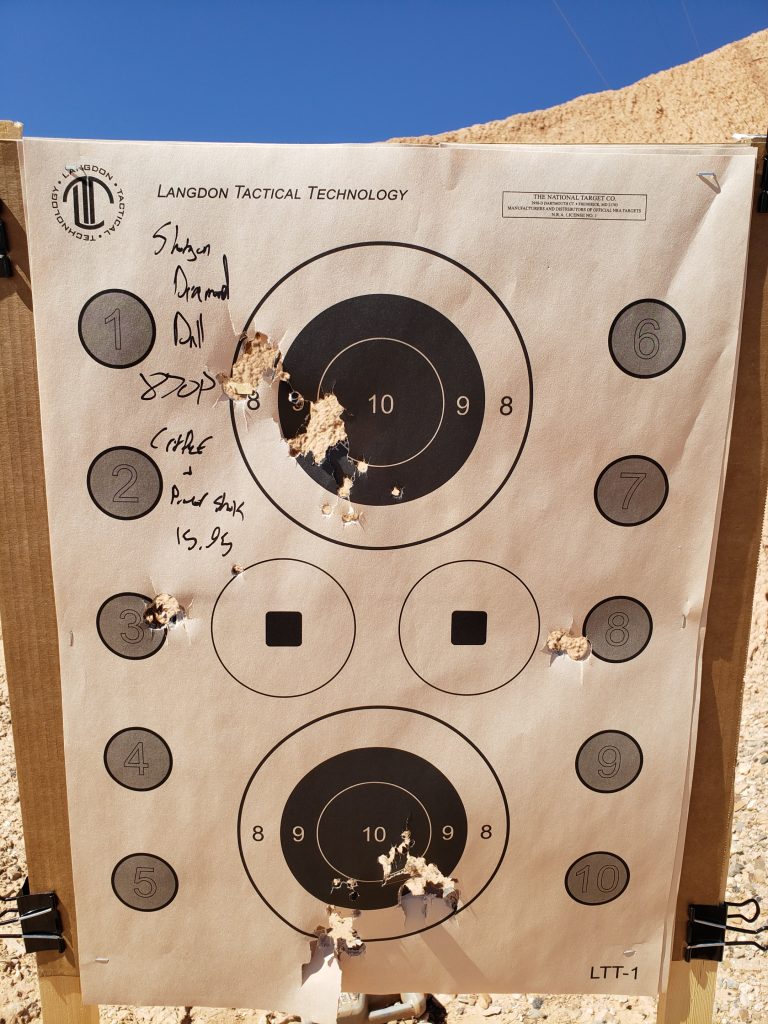
With my current skill level, I haven’t found much difference between pump action and semiauto shotguns on this drill. The biggest challenge is steadying my sights and getting a good press on the slugs, which is where I typically fail. Where I see most shooters run into issues here is during their loading between targets. Often people will bobble back and forth between the magazine and ejection port, their brain locking up as they race to be fast rather than deliberate. Work on your manipulations, get your hits, then worry about speed.
Final Thoughts on the Shotgun Diamond Drill
There’s probably some bias here, but I really like the Shotgun Diamond Drill. I think it tests a wide variety of skills while keeping the administrative burden on the shooter low. It can be done with any shotgun, and virtually any load–though poor patterns will be punished. The par times get spicy on the faster end, but shooters have plenty of room to grow. With speed and accuracy being emphasized, there’s surely something that any shooter can work on here.
What do you think of the Shotgun Diamond Drill? Give it a try next time you go to the range, and tell us your scores in the comments.
Author’s Note: Thanks to Nate over at That Shotgun Blog for giving the Shotgun Diamond Drill some runs and providing feedback. Once again you’ve been a big help helping to sanity check my work, and your feedback is always valuable.
Support My Work
If you made it this far, thanks for reading! Writing isn’t my full-time profession, and nearly everything I do comes out of my own pocket. Between ammunition, tuition, range fees and more, expenses add up fast. If you like what I have to offer, consider making a donation to my Patreon.
Every bit helps bring more work like this to you, and contributes to shortened timelines or more in-depth work on my part. You’ll also have more direct access to me, offering suggestions for future projects, looking behind the scenes, and getting early access to some content. You can find my Patreon >>HERE<<



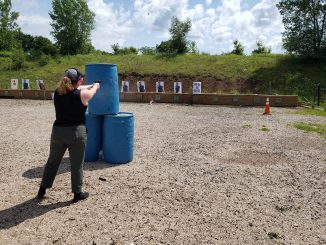
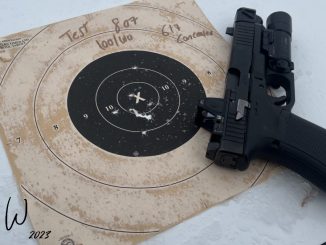
1 Trackback / Pingback